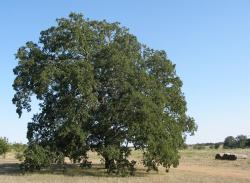KentPfeiffer said:Post Oak is often a scraggly-looking, smallish tree. But, it is certainly capable of reaching a large size (up to 100 feet tall) with nice form when it's growing in decent soil.
On behalf of all the beautiful Post Oaks growing on the edge of west Texas less than 20 more miles west where the only things that grow well have thorns and sting, I resent that statement

. I guess compared to an east Texas grown specimen, someone might consider them scraggly, but they are the core of the native landscape here and cope under arid and windy conditions. Here's one to make the case

. The posts left in the photo are bundles of 50-60 8'x6" prox to give some idea of the size of the tree. They really aren't very close to the tree, either.

For comparison, here's a Blackjack Oak. I hope the difference in form and density of the leaf canopy show well enough. In our area, they are the 2nd most common native oak. (There's a little Red Oak sapling in the foreground, but I grew that from an acorn so it's not native growth).




